ASIA ELECTRONICS INDUSTRYYOUR WINDOW TO SMART MANUFACTURING
Japan Tech Leaders Develop Sub-terahertz 6G Device
NTT DOCOMO, INC., NTT Corporation, NEC Corporation, and Fujitsu Limited jointly announced the development of a top-level (1) wireless 6G device. Particularly, the cutting-edge device is capable of ultra-high-speed 100Gbps transmissions in the 100GHz and 300GHz sub-terahertz bands.
Since 2021, the four companies have been jointly conducting R&D on sub-terahertz devices in anticipation of the coming 6G era. To date, tests of a jointly developed wireless device have achieved ultra-high-speed 100Gbps transmissions in the 100GHz and 300GHz bands at distances of up to 100 meters.(2) By comparison, 100Gbps is approximately 20 times faster than the maximum 4.9Gbps(3) data rate of current 5G networks.

The roles and achievements of the four participating companies are described below.
DOCOMO
DOCOMO has analyzed the wireless system configuration and performance required for 100GHz telecommunications applications. Following this, it has developed wireless transmission equipment capable of transmitting data rates equivalent to 100Gbps at a distance of 100 meters.
NTT
Based on research into 300GHz wireless devices and related equipment such as wideband mixers, NTT developed a top-level wireless device capable of transmitting 100Gbps per channel at a distance of 100 meters in the 300 GHz band.(1)
NEC
After analyzing a wireless system configuration for telecommunications in the 100GHz band, NEC developed a multi-element active phased array antenna (APAA) (1) consisting of more than 100 antenna elements.
Fujitsu
Fujitsu was responsible for the research of compound semiconductor technologies that enable high-output, high-efficiency signal amplification. Particularly, these technologies will extend communication range and reduce power consumption in the 100 and 300GHz bands. Therefore, Fujitsu achieved the highest power efficiency (4) in a high-output amplifier.
In the 6G era, wireless networks are envisioned to support diverse applications. These range from ultra-HD video streaming to real-time control in autonomous vehicles. Also, 6G will increase communication demands, high-capacity wireless communication. It will be achieved by exploiting the abundant bandwidth available in the sub-terahertz band from 100 to 300GHz. However, compared to 28GHz and other millimeter bands used in current 5G systems, the much higher frequencies of the sub-terahertz band will require entirely different wireless devices that are now being developed from scratch. To be successful, this effort will need to overcome several key challenges. Among them include determining the specific performance requirements of wireless devices operating in the sub-terahertz band. Following that is the actual device development.
Going forward, the four companies will continue to conduct extensive R&D into sub-terahertz telecommunications. Specifically, they will leverage each company’s strengths in various initiatives to contribute to 6G standardization.
Note: The research and development mentioned herein includes results from the Research and Development for Expansion of Radio Wave Resources project conducted on behalf of the Ministry of Internal Affairs and Communications.
[1] This assumes that as of March 2024, no other entity has announced 1) achievement of 100 Gbps transmission over a distance of 100 meters in the 100 GHz band (according to NEC); 2) achievement of 100 Gbps transmission over a distance of 100 meters in the 300 GHz band (according to NTT); and 3) achievement of an equivalent isotropic radiation power (EIRP) of 50 dBm and a beam steering angle of approximately ±30 degrees using 100 or more APAA elements in the 100 GHz band (according to NEC).
[2] The transmitter and receiver are facing each other in a straight line with no obstacle between them.
[3] Maximum values specified in technical standards, but not representing the actual data rate, provided on a best-effort basis. Actual data rates may vary depending on the communication environment and network congestion.
[4] World’s highest efficiency under specific high-power conditions in the 100 and 300GHz bands, respectively, according to Fujitsu as of March 2024.
-12 April 2024-




